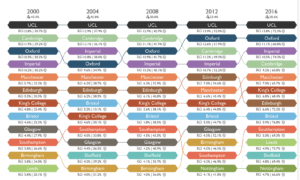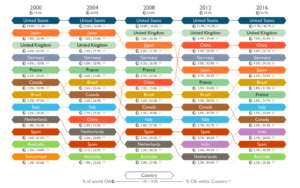Subscribe to our newsletter
Factors Influencing Open Access in UK Research Institutions
The Open Access movement has been slowly gaining traction with substantial gains being made in the last 20 years or so. Traditionally, the publication of research in peer-reviewed journals was paid for via subscription to journals – the “pay to read” model. More recently, Open Access has pushed publishers towards a “pay to write” model. Each model has pros and cons, but on this point of Open Access, the fundamental point is a philosophical one: Is it better that everyone in the world can read content for free or is it better than everyone in the world can afford to publish? In a broader setting, these are not the only options – Open Access comes in a number of flavours.
The Open Access publishing choices are varied. From journals where the content is free to read immediately on publication (‘gold’ Open Access), to journals that allow the same content published in the paper to reside in a repository such as arXiv following moderation or peer-review (‘green’ Open Access). Other options include where a journal allows works to initially be accessed by subscribers with an embargo period, after which the work can be accessed by others for free (‘hybrid’ Open Access), among others. Wider access to published work should lead to a greater awareness and understanding of the work being carried out across the world. Essentially, the issue is one of copyright assignment of the author to the publisher, or not. This is subtle issue and not one that we will spend time on here. Rather we wish to assess, at high level, how much research content is currently being produced that is free to read.
In order to monitor progress towards a more open research culture, we need to take a snapshot of the situation at different points of time and compare the percentage of Open Access outputs. This is where Dimensions comes in. With over 101 million publications contained within it, Dimensions is more than just a search engine; it offers researchers, Institutions funders and librarians access to a wealth of data around funding, international collaboration, and Open Access, to name just a handful of the facets of information available for analysis. Dimensions was built based on the needs of the community it serves, whether they are researchers, institutional strategists, funders, or publishers.
We recently published a report on The Ascent of Open Access, which looked at trends in Open Access, funding, and international collaboration individually. The data was also analysed to determine whether a change in one of these areas has an impact on others, and what that relationship might look like. One part of the report focused on the top 12 contributors to worldwide Open Access publication between 2000 and 2016. The dates were chosen because Open Access had become well established by 2000, when for example PLOS was launched. The endpoint of the analysis was taken to be 2016 since most articles that become free-to-read don’t have more than a 2-year embargo period on them. After 2 years, we can see a relatively stable figure emerging for the amount of content that is available freely to the research community and beyond, and can compare this to the amount of content that is likely to remain closed. It is important to note that some subjects, such as economics and physics, were earlier adopters of Open Access, and may have gone some way to driving the Open Access revolution in countries where they excel in research in these areas.
The Ascent of Open Access Digital Research Report uses Dimensions data to determine which 12 countries have contributed the most towards global Open Access output over a 16 year period.
Analysis of Dimensions data revealed that the volume of Open Access publications has been rising, but so had the volume of research, as we would expect. The top 12 countries by research volume in 2000 mostly remained in the top 12 by 2016, with Switzerland and the Netherlands dropping out of the top 12 to be replaced by China and India. From this analysis in the report, it is clear to see that the countries which have invested in Open Access have seen an increase in International collaboration.
The United States remained top in terms of the percentage of world Open Access output, but the percentage of Open Access outputs within the country is no longer increasing, and has plateaued, especially when compared to the increase in many other countries. For example, the UK went from third place in terms of percentage of world Open Access output in 2000 to second in 2016, but its percentage of Open Access within the country has more than doubled, from 22% to 52% in this time period. In terms of national Open Access percentage, the UK top the table, with Brazil taking second place.
The report showed that Open Access, funding, and international collaboration seem to support each other. It could simply be that the three are linked by finances; if a country can afford one of these things, it can afford the others. A driver for progression in each of these areas is an assumed underlying link to higher citation or altmetric attention. It has often been suggested that Open Access, funding and international collaboration contribute to enriching and diversifying the research environment and hence lead to better quality outcomes. However, a causal link between open access and higher quality has not be shown conclusively at the time of writing. We are also careful to delineate quality and attention. What is clear is that research published through open access routes can be discovered, shared and developed further by others more rapidly. Given the potential benefits it is surprising that the move to open access does not happen spontaneously or quickly and that progress in this area appears only to happen as a result of many initiatives that have been put into place to encourage more open research within these countries.
When we look at the UK for example, there have been many prompts to encourage researchers and institutions to publish their work as Open Access, and that these initiatives have been implemented from a range of angles. The Russell Group for example have specific policies about Open Access for their member institutions. The Finch Report was another driver for a stronger commitment to Open Access in the UK from the Government. And of course, given that it is 2019, a mere two years from REF 2021, it feels appropriate to sound the REF klaxon, as all REF 2021 submissions must be available as Open Access. Given that a good REF result is linked to access to QR funding, REF is proving to be quite the driving force behind institutional adoption of Open Access publication.
Dr Daniel Hook delved further into Dimensions data to see how some of these initiatives are pushing forward the Open Access agenda in UK universities. Looking at the Russell Group universities alone, it is clear to see that UCL have been leading the way in Open Access adoption for some time now. In the period analysed, UCL have consistently contributed the greatest proportion to UK Open Access output, while their institutional adoption has also been one of the highest, if not the highest, across many of these years also. In 2016, Bristol, Imperial College London and Leeds all had a higher institutional Open Access output than UCL, but UCL are still contributing a higher proportion to the UK’s overall Open Access output, suggesting that UCL’s continued commitment to Open Access could be linked to its increased volume of research output. Of course, such a commitment comes with a level of financial commitment from the institution in question, and must also be supported by a framework of education and outreach in order for the institution and its researchers to successfully adopt Open Access. Other institutions consistently contributing a high percentage to the total Open Access output of the UK are Cambridge, Oxford, Imperial College London, Manchester and Edinburgh, who all more or less stay within the top six.
 A deeper dive into Dimensions data reveals the top 12 UK research institutions contributing to the UK’s Open Access output across a 16 year period. During this time, UCL have consistently outperformed all other institutions in terms of its percentage contribution to the total Open Access output for the UK, with a consistent increase in its institutional adoption of Open Access, thanks to a range of successful Open Access initiatives.
A deeper dive into Dimensions data reveals the top 12 UK research institutions contributing to the UK’s Open Access output across a 16 year period. During this time, UCL have consistently outperformed all other institutions in terms of its percentage contribution to the total Open Access output for the UK, with a consistent increase in its institutional adoption of Open Access, thanks to a range of successful Open Access initiatives.
When presenting this work at the Focus on Open Science event at UCL in May, the Open Access team from our host institution said they were much closer to total Open Access adoption. This was largely driven by the requirement that all REF submissions in the REF 2021 exercise are available as Open Access, alongside recommendations from the Russell Group, and guidelines from the UK government. Such a high-level commitment to Open Access publication of research can only be achieved by initiatives from a range of stakeholders that incentivise and encourage adoption of Open Access. The latter seems to be paying off in terms of the productivity of researchers at these institutions, evidenced by the volume of country-wide Open Access output generated by these institutions, which goes some way to confirming that Open Access and open research has an overall positive impact on research productivity as a whole.
While it should be noted that, as DORA signatories, we believe in and support the responsible use of metrics, analyses such as these are good indicators of the impact that Open Access can have, not just for individual researchers who wish for their work to be widely read and developed on, but institutions and countries who wish to contribute to the research landscape in the most productive way possible.

